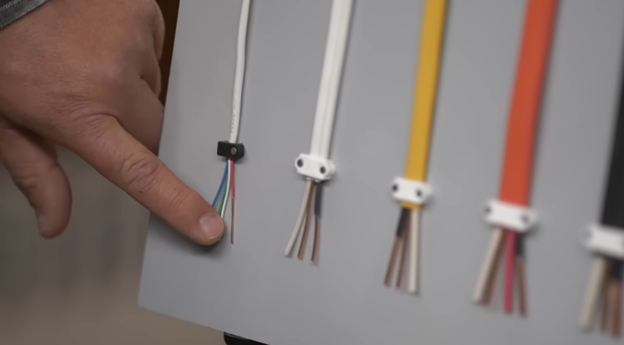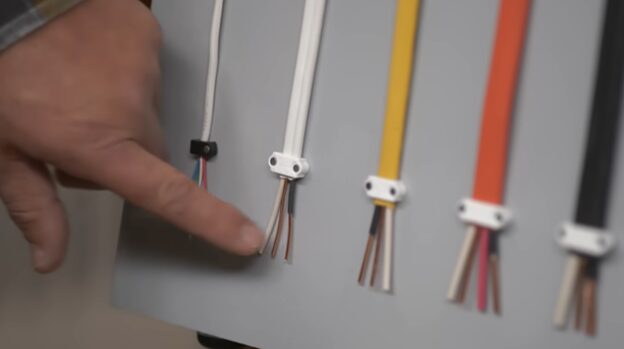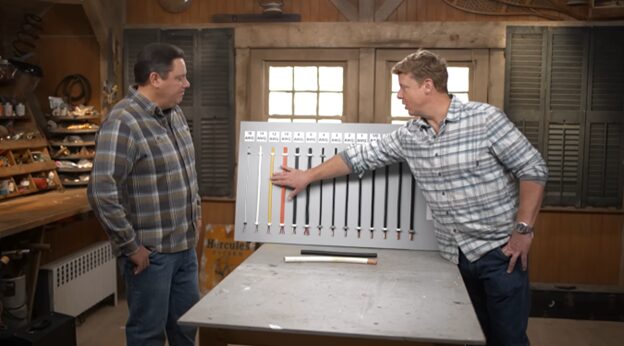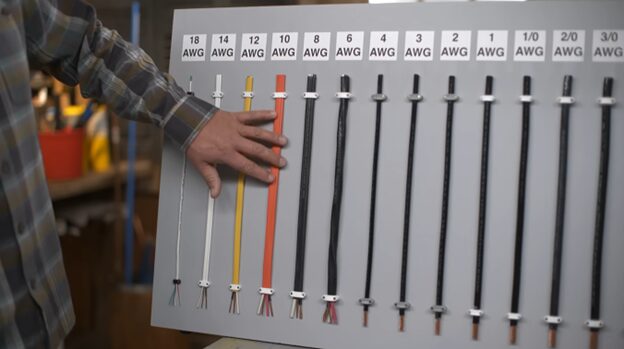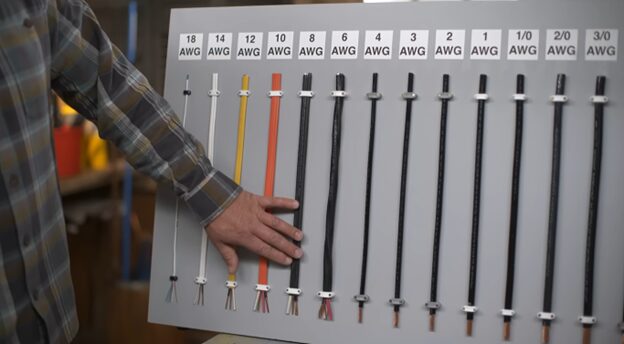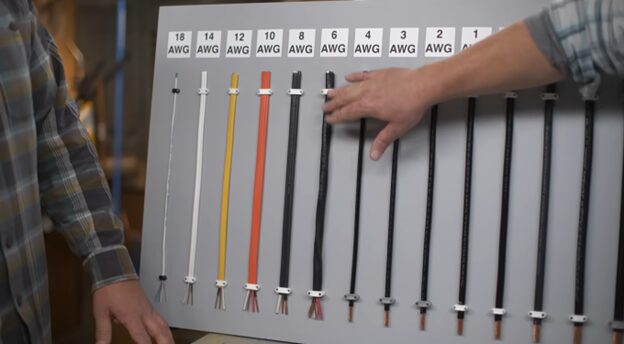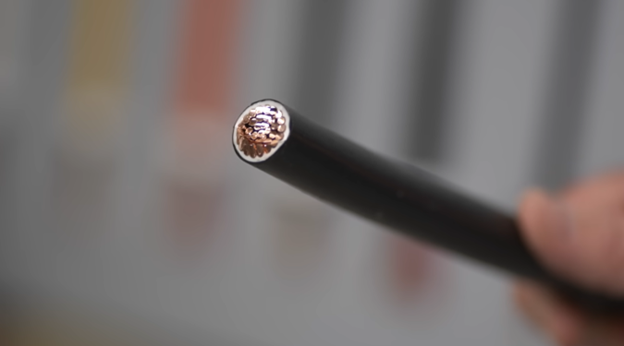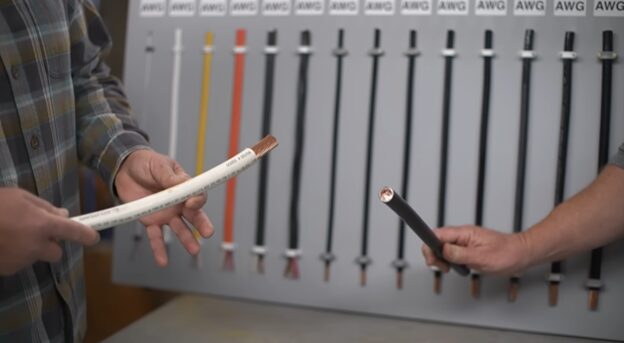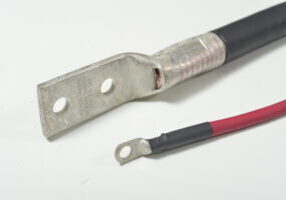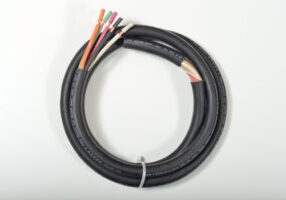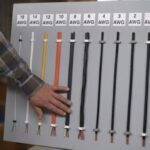
Aug 24, 2024
Understanding Wire Gauges and Typical Applications (Home Wiring)
Wire gauges in electrical wiring refer to the thickness or diameter of the wire, and they are measured according to the American Wire Gauge (AWG) system. AWG is a standardized system that categorizes wires by their diameter, with smaller numbers indicating thicker wires and larger numbers indicating thinner wires. The range from 18 AWG to 4/0 AWG includes a variety of wire sizes suited for different applications, from delicate electronics to large-scale industrial systems.
In this explanation, I’ll describe the differences between these wire sizes, their uses, and the concept of AWG in detail.
0:13 – AWG Meaning
0:44 – 18AWG Thermostats
0:57 – 14 AWG Romex for lighting
1:22 – Multiconductor
2:00 – GFCI information
3:20 – Larger sizes
What is AWG?
The American Wire Gauge (AWG) is the standard used in North America for specifying the thickness of electrical wires. The system was established in 1857 and remains a vital part of the electrical industry. AWG is logarithmic, meaning that every three-gauge decrease roughly doubles the cross-sectional area of the wire. For example, 12 AWG wire is about twice as thick as 15 AWG wire.
The smaller the AWG number, the thicker the wire, and vice versa. For instance:
- 18 AWG wire is thin and flexible.
- 4/0 AWG (pronounced “four-aught”) is much thicker and used for carrying heavy currents.
AWG scale’s significance lies in the ability of the wire to carry current without overheating. As wire diameter increases, so does the amount of current it can carry safely, but it also becomes stiffer and harder to work with.
The Wire Gauges: From 18 AWG to 4/0 AWG
Here’s a breakdown of wire sizes from 18 AWG to 4/0 AWG and their typical applications:
18 AWG (0.0403 inches in diameter)
- Common Use: This is a relatively thin wire, often used in low-voltage applications.
- Applications: Speaker wires, LED lighting, thermostat wiring, small appliances, and doorbell circuits.
- Current Capacity: Typically rated for 10-16 amps in short runs (depending on insulation and installation methods).
18 AWG wire is flexible and easy to work with. Its small diameter makes it well-suited for delicate electronics where space is tight and current demands are minimal.
16 AWG (0.0508 inches in diameter)
- Common Use: Slightly thicker than 18 AWG, 16 AWG wire is used where slightly higher currents are required.
- Applications: Extension cords for small appliances, automotive wiring, and lighting.
- Current Capacity: 16-22 amps, depending on insulation.
This gauge is common in household electronics and automotive systems because it can handle more current than 18 AWG but is still flexible.
14 AWG (0.0641 inches in diameter)
- Common Use: 14 AWG wire is the smallest size commonly used in household wiring circuits.
- Applications: Lighting circuits, outlets in homes, and small appliances.
- Current Capacity: Typically rated for up to 15 amps, making it suitable for standard lighting and outlet circuits in residential buildings.
This is one of the most widely used wire gauges in residential wiring because it balances current-carrying capacity with flexibility and cost.
12 AWG (0.0808 inches in diameter)
- Common Use: 12 AWG ground wire is thicker than 14 AWG and is commonly used in circuits that require more power.
- Applications: Household circuits, kitchen appliances, water heaters, and air conditioning units.
- Current Capacity: Rated for up to 20 amps in residential wiring.
12 AWG is often used in homes for circuits that power high-current appliances like microwaves or window air conditioners. It’s also used in outdoor applications due to its durability.
10 AWG (0.1019 inches in diameter)
- Common Use: 10 AWG wire is a thick wire used in circuits that require significant power.
- Applications: Electric dryers, ovens, water heaters, and large air conditioning units.
- Current Capacity: Typically rated for 30 amps.
This wire gauge is used for large appliances and in outdoor electrical systems, such as powering subpanels or outdoor lighting.
8 AWG (0.1285 inches in diameter)
- Common Use: 8 AWG wire is designed for heavy-duty circuits.
- Applications: Electric furnaces, hot tubs, and large HVAC systems.
- Current Capacity: Typically rated for 40-55 amps.
This wire size is often used in industrial and commercial settings, as well as for large residential equipment. It provides a balance between current-carrying capacity and flexibility for heavy electrical loads.
6 AWG (0.162 inches in diameter)
- Common Use: 6 AWG wire is used in even larger circuits with higher current demands.
- Applications: Electric stoves, solar panel systems, and central air conditioning units.
- Current Capacity: Typically rated for 55-75 amps.
6 AWG is commonly used in applications where high current is necessary, but the wiring must remain flexible enough for installation in tight spaces.
4 AWG (0.2043 inches in diameter)
- Common Use: 4 AWG wire is used for very high-current circuits.
- Applications: Large residential service panels, high-current welding equipment, and large battery banks.
- Current Capacity: Rated for 70-95 amps.
4 AWG wire is robust, and its thicker diameter makes it ideal for applications requiring very high currents, such as connecting to large batteries or power inverters.
2 AWG (0.2576 inches in diameter)
- Common Use: This gauge is commonly used in large-scale power distribution applications.
- Applications: Subpanels, large inverters, and industrial machines.
- Current Capacity: Typically rated for 95-130 amps.
2 AWG wire is used in situations where a significant amount of power needs to be transferred over a relatively short distance, such as in industrial settings or large residential installations.
1 AWG (0.2893 inches in diameter)
- Common Use: 1 AWG wire is used in high-power applications and large systems.
- Applications: Heavy-duty power transmission for industrial systems, backup power systems, and large battery banks.
- Current Capacity: Typically rated for 110-150 amps.
This wire size is capable of handling high currents and is used in power distribution systems for commercial and industrial buildings.
1/0 AWG (0.3249 inches in diameter)
- Common Use: Also called “0 AWG,” this wire is used in very high-current applications.
- Applications: Battery banks, welding cables, and large inverters.
- Current Capacity: Typically rated for 125-170 amps.
This gauge is thick and sturdy, commonly used in power transmission between large systems, such as solar panel arrays and power storage systems.
2/0 AWG (0.3648 inches in diameter)
- Common Use: 2/0 AWG wire is for even more demanding high-current applications.
- Applications: Main power lines to residential homes, large battery banks, and industrial power distribution.
- Current Capacity: Typically rated for 150-195 amps.
2/0 AWG wire is used to handle large power demands, especially in industrial and commercial settings, or for large residential service entries.
3/0 AWG (0.4096 inches in diameter)
- Common Use: 3/0 AWG is used for very large-scale power distribution.
- Applications: Large-scale electrical installations, such as commercial service entries and utility connections.
- Current Capacity: Typically rated for 200-225 amps.
This wire size is heavy and difficult to work with, but it’s essential in applications that demand very high current capacity.
4/0 AWG (0.460 inches in diameter)
- Common Use: 4/0 AWG is the thickest commonly used wire and is intended for the most demanding power applications.
- Applications: Main service entry for large buildings, industrial power systems, and high-power battery connections.
- Current Capacity: Typically rated for 230-260 amps.
4/0 AWG wire is the most robust, used in large commercial and industrial settings, where massive amounts of electricity need to be transmitted safely.
Why Are There Different Wire Gauges?
The difference in wire gauges is primarily due to the varying electrical requirements of different systems and devices. Smaller wire gauges (higher AWG numbers) are used in applications where only small currents are needed, and space or flexibility is important. Larger wire gauges (lower AWG numbers) are used in situations where more power is required, but the wire’s thickness makes it harder to handle.
- Smaller Wires (18-14 AWG): Used in low-power applications such as electronics, lighting, and household appliances. They are flexible and easy to install but cannot handle large currents without overheating.
- Medium Wires (12-8 AWG): Used in moderate-power applications like household wiring and medium-sized appliances. These wires are thicker, allowing them to carry more current safely.
- Larger Wires (6-4/0 AWG): Used in high-power applications such as industrial equipment, large appliances, and main power lines. These wires can handle large amounts of current, but they are stiff and difficult to install in tight spaces.
Conclusion
The AWG system provides a standardized way to measure and categorize wire sizes based on their diameter and ability to carry current. From 18 AWG to 4/0 AWG, the wire’s thickness increases, allowing it to carry more current and handle higher-power applications.
Smaller gauges like 18 AWG are used for low-power tasks like lighting and electronics, while larger gauges like 4/0 AWG are employed in high-power industrial and utility systems.

